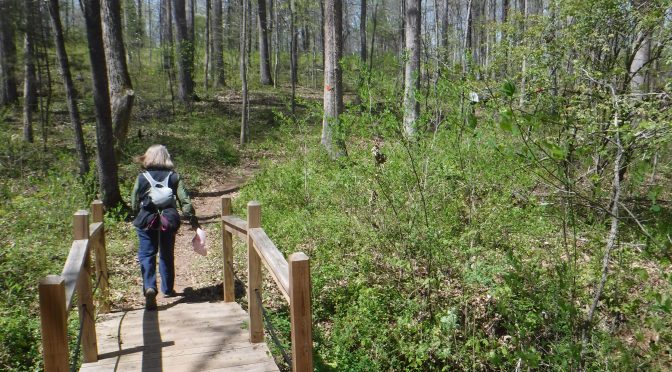All of North Carolina’s 41 State Parks have closed their visitor centers, restrooms, camping and other touchy facilities, while another 29 have closed completely, including trails. And while the latter is an understandable bummer, it overshadows the fact that you can still hike in the 12 remaining parks.
We’ve compiled a list of those parks, including miles of hiking trail, and added a thought or two about why they make for good hiking (or in some cases don’t) if you’re in the area.
Carolina Beach State Park
Carolina Beach (10 miles south of Wilmington)
Hiking trail: 9 miles
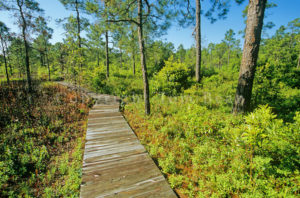
A worthy loop is the 4.5-mile hike from the Flytrap Trail parking area, but starting on the Sugarloaf Trail. Hike west, toward the Cape Fear River. You’ll hike mostly through pine savannah on white sand, then through maritime forest, a nice mix. There’s an excursion up the forested 60-foot Sugarloaf Dune; there, take the Sand Live Oak Trail, which meets back up with Sugarloaf. Pass three ponds before returning to the trailhead.
Goose Creek State Park
Washington (30 miles southeast of Greenville)
Hiking trail: 8.5 miles
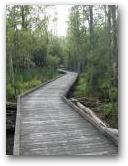
From the Visitor Center (closed) hike the Palmetto Boardwalk above a dense marsh to the Ivey Gut Trail, which buddies up briefly to Goose Creek, then pick up the 2.5-mile Goose Creek Trail for views of the Pamlico River, then the Mallard Creek Loop, which visits its namesake creek. This is coastal wetlands hiking at its best, with passage through marsh, and black gum and cypress swamps.
Hammocks Beach State Park
Swansboro
Hiking trail: 2.6 miles
Hammocks Beach is best known for Bear Island, a barrier island reached by ferry (not running) or kayak (the boat access is closed). But on the mainland you’ll find a good 2 miles of hiking on four interconnected trails — Live Oak, Evergreen, Hickory Bluff and Coastal Fringe — that explore coastal forest.
Haw River State Park
Greensboro
Hiking trail: 3.9 miles
A bit of a surprise that the park’s Iron Ore Belt Access on the north edge of town remains open. It’s home to the popular Great Blue Heron Loop Trail, which somehow stays relatively level while probing a hilly wooded area. Mature forest, meadow, the headwaters of the Haw River, and hiker-friendly tread make this one of the best hiking options in the Piedmont.
Jockey’s Ridge State Park
Nags Head
Hiking trail: 1.9 miles
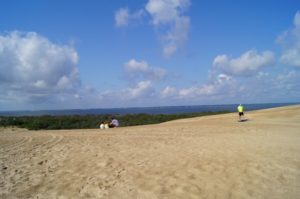
NOTE: The park is only open to residents of Dare County; the county remains closed to non residents.
Two options. From the park’s main entrance, the 1.2-mile Tracks in the Sand Trail takes you over the dunes to Roanoke Sound (a good opportunity to do your best Lawrence of Arabia impression). From the secondary entrance off West Soundside Road, the 0.6-mile Soundside Nature Trail takes you through a very different environment: a maritime shrub thicket. Bring a kite.
Jones Lake State Park
Elizabethtown (40 miles southeast of Fayetteville)
Hiking trail: 6 miles (a portion of which is the Mountains-to-Sea Trail)

Another trail very high on our list of favorites: the Bay Trail, a 4-mile loop circling Jones Lake. Hiked clockwise from the Visitor Center (yes, closed), you start in a pine forest with good sun. At roughly the midpoint, on the northern side of the lake, you’re suddenly transported into a dense coastal forest of pond cypress festooned with Spanish moss and a plethora of bays and other coastal vegetation. For extra credit hiking, take the mile-long spur (2 miles out and back) to Salters Lake.
Kerr Lake State Recreation Area
Henderson
Hiking trail: 1.5 miles (roughly)
Hiking really isn’t a thing at Kerr Lake, where the eight recreation areas are devoted to boating, swimming and fishing. What trails there are are short campground paths.
Medoc Mountain State Park
Hollister (30 miles northwest of Rocky Mount)
Hiking trail: 10 miles, with an additional 9 miles of mountain bike trail
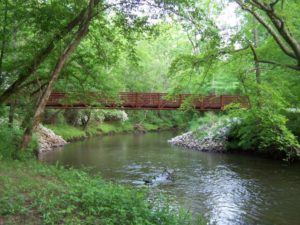
Located well off the beaten path, Medoc Mountain has long been an under-appreciated hiking destination. On the interconnected trail network you can hike along Little Fishing Creek, up 300-foot Medoc Mountain, past the remains of the first winery in the New World and through maturing Piedmont hardwoods.
Merchants Millpond State Park
Gatesville (near the Virginia border in northeastern N.C.)
Hiking trail: 9 miles
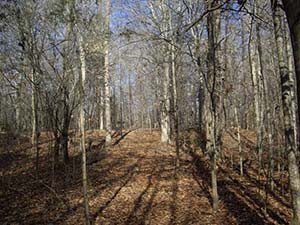
Best known for canoeing on its 760-acre millpond, Merchants Millpond also has a diverse trail network that’s ideal for a long walk on flat terrain. Most of the trails are wide, meaning you can hike here in summer and minimize your risk of contact with ticks and itchy plants.
Pettigrew State Park
Creswell (not far off U.S. 64 on the way to the Outer Banks, in Washington and Tyrell counties)
Hiking trail: 9 miles, some of which is open to mountain bikes
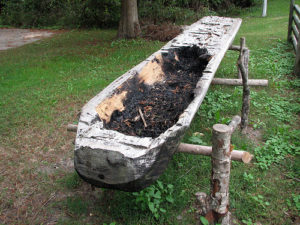
Are you a gawker? Then you need to hike the 2.8-mile Moccasin Trail, which takes you past some of the oldest, biggest trees in the state, including sweet gums, persimmons, pawpaws, bald cypress with trunks 10 feet in diameter and cedars that top 100 feet. Great hiking along Lake Phelps as well.
Singletary Lake State Park
Kelly (in Bladen County, 50 miles northwest of Wilmington)
Hiking trail: 1 mile
The mile-long CCC Loop Trail offers a good introduction to a bay forest. Nearby, though, you’ll find the Bay Tree State Natural Area, a 620-acre forest of longleaf pine, Carolina bay and xeric sandhill upland that houses a nearly 5-mile trail. It also presents an opportunity for some diverse wildlife viewing. Reads the website: “Hikers are cautioned that trails may feature venomous snake species to include Southern copperhead, cottonmouth moccasin, pygmy and canebrake rattlesnakes.”
Weymouth Woods Sandhills Nature Preserve
Southern Pines
Hiking trail: 7.3 miles (some of which is open to horses)
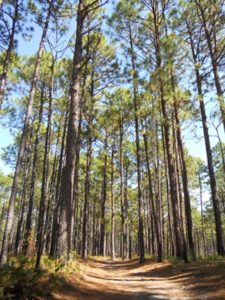
As the preserve’s name would suggest, there’s ample hiking through sandhill terrain, beneath expansive longleaf pines, and that is probably the main attraction. But we love the fact that on the Pine Island Trail you suddenly dip into a lush wetland (much of which is boardwalk). A little like finding an oasis in the desert.
